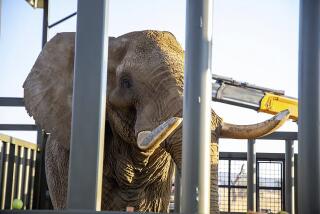The latest threat to African elephants and rhinos? Terrorist groups
My family has had its own loss at the hands of poachers. In 2010 we visited the David Sheldrick Wildlife Trust orphanage for young elephants, a popular tourist attraction outside Nairobi, Kenya.
We were enchanted by the tiny, affectionate babies, so we “adopted” four of them for $50 each a year. Three of our elephants were orphaned when poachers had killed their mothers for ivory; the fourth was orphaned when its mother had fallen down a well.
Two died within weeks of our adopting them — elephants are so sensitive that 50% of Sheldrick’s orphans perish — and two lived to be released in Tsavo East National Park. Four years later, one of our remaining elephants was killed for its ivory.
About 100,000 African elephants were slaughtered from 2010 through 2012, according to a 2014 article in the Proceedings of the National Academy of Sciences. Of the millions that roamed the continent 50 years ago, there are estimated to be 400,000 to 500,000 remaining. Right now, according to the Wildlife Conservation Society, 96 elephants are killed every day for ivory. At this rate, there will be no elephants left in 20 years.
Rob Brandford, director of iWorry, a Britain-based elephant conservation campaign, estimated that a live elephant is worth $1.6 million in tourist dollars over its lifetime, while tusks on a dead one may bring in $21,000 to Africa.
“And now terrorist groups like the LRA [Lord’s Resistance Army], al-Shabaab, Al Qaeda and Boko Haram fund themselves through ivory and rhino horn trade,” he added. “We seize 10% of ivory contraband. Most of the proceeds from killing elephants go toward killing people.”
I returned to Kenya in July and stopped at the Sheldrick orphanage. Angela Sheldrick, the determined daughter of David and his wife, Daphne, now runs the organization. “Until the desire for ivory is removed, the elephant holocaust will continue,” she told me.
“Poachers are paid an astronomical amount compared to the typical salary here. That’s a strong incentive for an African villager.” Then she shocked me by saying, “The United States is the second-largest retail ivory market after Asia.”
Walk through Chinatown stores in San Francisco and New York and you’ll find it, often dyed to look old.
Ivory, often called “white gold,” is a status symbol in Asia, where it is used to create a perception of wealth. This year the Chinese government pledged to phase out the legal importation of ivory. The problem, of course, is the illegal importation.
Richard Bonham, a Brit-turned-Kenyan, is co-founder of Big Life, a nonprofit conservation effort he started with Los Angeles-based photographer Nick Brandt. Big Life is based near Ol Donyo Lodge in southeastern Kenya, a Maasai-owned area adjacent to Amboseli National Park.
“The elephants know Ol Donyo is secure,” Bonham said. He and his 300 Big Life rangers run anti-poaching patrols, compensate villagers when a marauding animal destroys crops or kills someone, and conduct programs to educate villagers on how poaching is stealing their heritage and livelihood.
“Elephants are highly sentient beings. They have emotions and language and remember everything that happens to them. Their social groups are highly sophisticated. Humans are not slaughtering dumb creatures,” he said.
The elephants at Ol Donyo are so comfortable with Bonham that he had to stop chlorinating his home’s swimming pool because the animals were using it as a watering hole. At cocktail hour, it’s not uncommon to see several elephants with massive tusks (a rare sight) serenely drinking from the now-greenish pool.
ALSO:
Help rescue wolves, toucans and other wildlife -- and see the world
At a wildlife center in Indonesia, macaques are readied for a return home
Like orangutans? You can volunteer at a ‘forest school’ for them in Indonesia
More to Read
Sign up for The Wild
We’ll help you find the best places to hike, bike and run, as well as the perfect silent spots for meditation and yoga.
You may occasionally receive promotional content from the Los Angeles Times.





